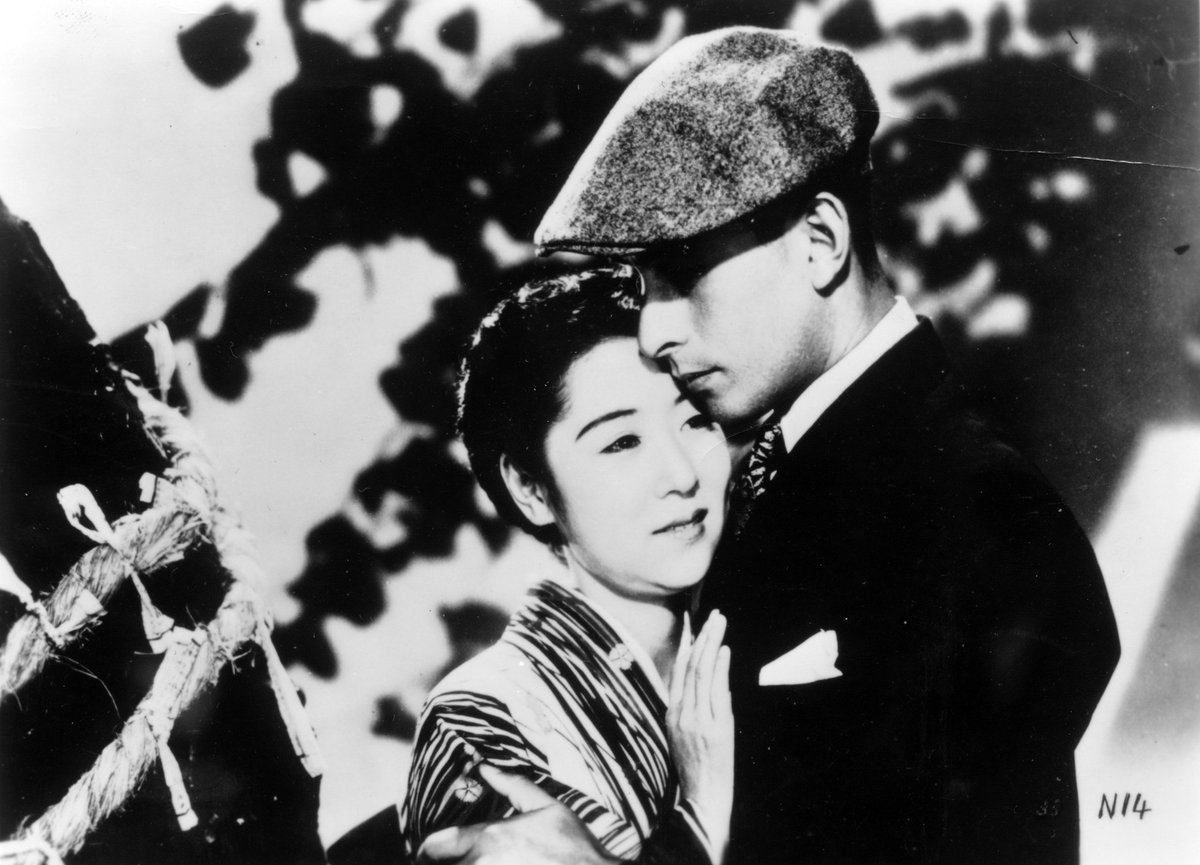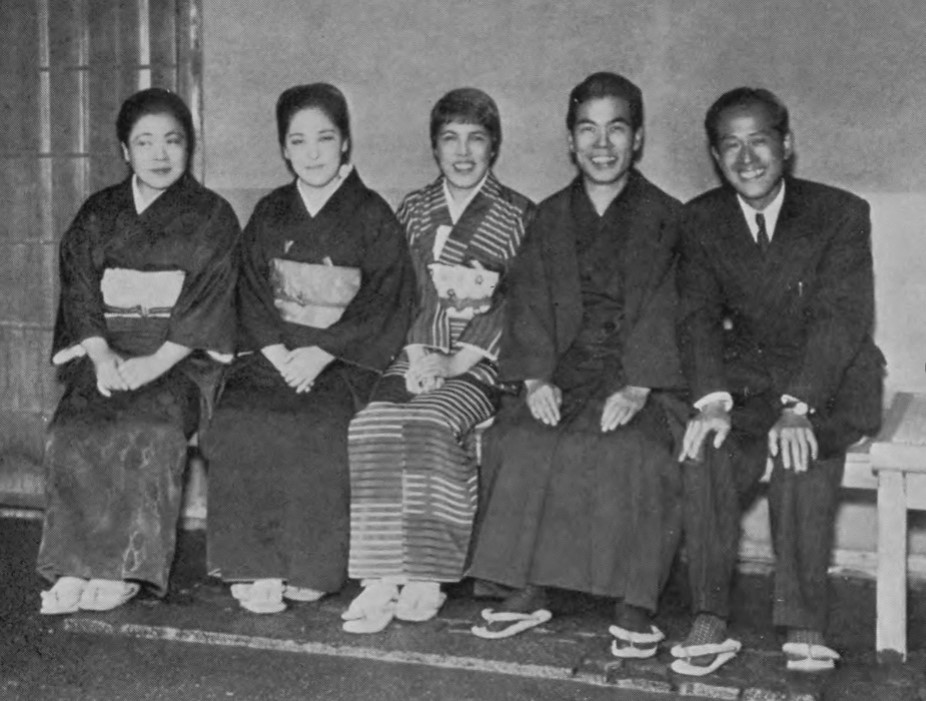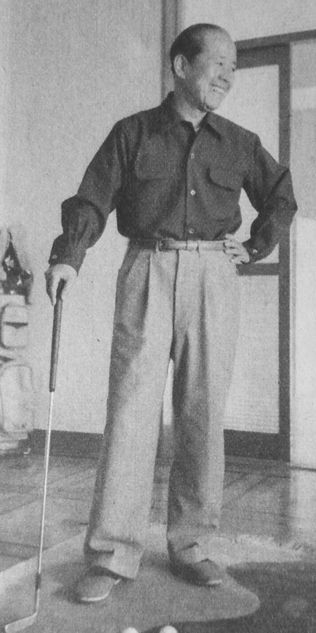1. Overview
Matsutarō Kawaguchi (川口松太郎Kawaguchi MatsutarōJapanese, October 1, 1899 - June 9, 1985) was a prominent Japanese writer, playwright, and screenwriter. Born in the Asakusa district of Tokyo, Kawaguchi became one of Japan's most widely read authors, known for his popular novels, short stories, and plays that often depicted the emotions and lives of common people. He achieved significant fame with works like Aizen Katsura and was the recipient of the inaugural Naoki Prize. Beyond his literary contributions, Kawaguchi was deeply involved in the film and theater industries, serving as an executive at Daiei Film and playing a crucial role in the Shinpa theater movement. His works were frequently adapted into successful films and television dramas, solidifying his cultural impact.
2. Early Life and Background
Matsutarō Kawaguchi's early life was marked by an uncertain family background and diverse experiences that shaped his later literary career.
2.1. Childhood and Education
Kawaguchi was born in Asakusa, Tokyo, specifically in Asakusa Imado-cho (present-day Imado, Taito Ward). His official family register states him as the illegitimate child of Kawaguchi Takejirō, who was recognized and registered by Yone Shimaoka's elder sister, Harukichi. The identities of his biological parents remain unknown. His adoptive father, Kawaguchi Takejirō, was a plasterer known for heavy drinking, and the identity of Yone Shimaoka is also unclear. There is speculation that Kawaguchi might have been from a Burakumin background, given the historical presence of Asakusa Shinmachi, a district under Danzaemon's control, in Imado. Another theory suggests he was the illegitimate child of a peerage family, and Kawaguchi himself recalled a formal document regarding childcare expenses sent to him as an infant, though it was lost in the 1923 Great Kantō earthquake.
He attended Imado Elementary School but withdrew in the fourth grade to work as an apprentice at a clothing store. When compulsory education was extended by two years, he re-enrolled in Yamaya-bori Elementary School. Among his classmates at Yamaya-bori were Kenji Mizoguchi and Shigenobu Maeda (Koizumi). Kawaguchi was an excellent student and graduated with honors, but he could not advance to higher education. He took on various jobs, including working at a pawn shop in Yamaya-cho, selling used books from a street stall near Asakusa Senso-ji Temple, and serving as an attendant at the Kisakata Police Station. He also passed the telegraph engineer examination for the Ministry of Communications and worked at telegraph offices in Saitama Prefecture and Tochigi Prefecture. From 1915 for about a year, he worked at the Soboi Post Office in Haga District, Tochigi Prefecture.
2.2. Start of Literary Activities and Influence
It was during his time at the telegraph office that Kawaguchi began writing novels. At the age of 17, with the assistance of Chōkai Ikuta, who had moved to Imado, he made his literary debut by publishing "Ryūzainin Tōsuke" (The Exiled Tōsuke) in Kōdan Zasshi (Storytelling Magazine). Through Ikuta's study group, he also became close with Maeda and Sentarō Iwata. He contributed new kōdan (storytelling), detective real-life stories, and koma-e (small picture) novels, often accompanied by Iwata's illustrations, to magazines affiliated with Hakubunkan, earning manuscript fees.
At 19, his adoptive father passed away, and his adoptive mother returned to her family home, leaving Kawaguchi orphaned. He lived in a rented room within the grounds of Hirakawa Tenman-gū Shrine in Kōjimachi. Later, through an introduction by Akekure Mori, the editor-in-chief of Bungei Club, he moved into the home of Gōdōken Entama, a popular kōdan storyteller from Fukagawa known for his rapid dictation. Kawaguchi assisted Entama with his oral transcriptions, which helped him develop his knowledge of Chinese poetry and Edo period literature. Through Entama, he also became a disciple of Mantarō Kubota and, through Kubota's introduction, participated in Kaoru Osanai's script research group, while also working as a reporter for the Yamato Shimbun. In 1922, his play "Shutsugoku" (Escape from Prison) was selected by Shōyō Tsubouchi and others for the Imperial Theater's 10th-anniversary play competition, winning alongside works by Tatsuo Nagai.
Following the Great Kantō Earthquake in 1923, at Osanai's recommendation, Kawaguchi worked with Iwata at Platon-sha in Osaka, where he collaborated with Sanju Naoki on editing the magazine Kuraku. He returned to Tokyo in 1926, dedicating himself to writing novels, essays, and plays. Around 1930, he began writing contemporary novels and film adaptations for Kōdansha Club. His serialized work "Joyū Jōen Shi" (History of Actress's Passion) from 1931 to 1932 gained significant acclaim, followed by historical works such as "Yuhiso no Heitarō" and "Hagidera Chōshichi".
In November 1933, during the investigation of the Delinquent Peerage Incident, habitual gambling among writers came to light. Kawaguchi was arrested along with Masao Kume and Ton Satomi and received a fine.
3. Literary Career
Matsutarō Kawaguchi's literary career was marked by his prolific output, his ability to capture the public's imagination, and his significant influence on popular Japanese literature, including his activities during wartime.
3.1. Emergence as a Popular Writer
In 1934, his human-interest story "Tsuruhachi Tsurujirō", set in the world of Meiji-era entertainers and published in All Yomimono, gained considerable popularity. From 1935, he serialized "Fūryū Fukagawa Uta" (Fukagawa Song of Elegance), a human-interest tale revolving around a traditional restaurant. These Meiji-era works led to him receiving the first Naoki Prize in 1935, nominated by Yoshie Wada, editor of Hinode magazine (who was close to Kan Kikuchi at the time), and Kōichi Kayanohara, editor of Kōdansha Club. He then wrote Meiji Ichidai Onna (A Meiji Woman), reportedly modeled on the case of Hanai Oume.
Following this, his novel Aizen Katsura, a melodramatic love story between a nurse and a doctor, became a massive bestseller. Its film adaptation, starring Kinuyo Tanaka and Ken Uehara, was an explosive hit, instantly elevating Kawaguchi to the status of a star author.

3.2. Major Works and Genres
Kawaguchi's literary output spanned a wide range of genres, including historical fiction, romance, and modern social commentary. He was particularly adept at crafting compelling narratives and unique storytelling that resonated with the common people's emotions. His historical novels include Shingo Jūban Shōbu (Shingo's Ten Duels), Kōjo Kazunomiya (Princess Kazunomiya), and Nyonin Musashi (Woman Musashi). In contemporary settings, his representative works include Yoru no Chō (Night Butterfly), which depicted women in Ginza, and Koto Yūshū (Sorrow of the Ancient Capital), which explored the film industry and entertainment districts of Kyoto. His lengthy autobiographical novel Yabure Kabure (Reckless) is also notable. After his wife's death, he published Aiko Itoshiya (My Beloved Aiko), which drew significant attention.
In the afterword to Shingo Jūban Shōbu, Kawaguchi stated, "I consider myself a storyteller. I hear there was a profession called 'kataribe' (storyteller) in the Heian era, and I wish to be such a 'kataribe'." His work Shigurejaya Oriku (Mistress Oriku: Stories from a Tokyo Teahouse), about the owner of a famous Tokyo teahouse, was translated into English by Royall Tyler in 2007.
3.3. Film and Theater Adaptations
Kawaguchi's works were widely adapted into films, and he himself contributed significantly to the film industry as a screenwriter. He repeatedly collaborated with director Kenji Mizoguchi, adapting other writers' works for films like The Story of the Last Chrysanthemums (1939). In turn, Mizoguchi adapted Kawaguchi's works, such as Ayen Kyo for The Straits of Love and Hate (1937). After World War II, their collaborations continued with films like Ugetsu (1953), The Crucified Lovers (1954), and Princess Yang Kwei Fei (1955). Mizoguchi also adapted Kawaguchi's story for his 1953 film A Geisha. His books were also adapted by other notable directors such as Mikio Naruse and Kōzaburō Yoshimura.

In 1940, Kawaguchi joined the theater group Shinsei Shinpa (New Shinpa), where he served as a director and adapted his own novels for the stage. He became an indispensable and popular writer for Shinpa during the Showa period, with many of his works becoming representative plays of the genre. During the Second Sino-Japanese War, Kawaguchi was a member of the Pen Butai (Pen Brigade), a government-sponsored group of writers who were granted access to restricted war zones and were expected to produce favorable accounts of Japan's war efforts in China.
4. Film and TV Drama Adaptations
Many of Matsutarō Kawaguchi's works were adapted into successful films and television dramas, showcasing their enduring popularity and cultural impact.
- Aizen Katsura (1938 film), directed by Hiromasa Nomura, starring Kinuyo Tanaka and Ken Uehara.
- Tsuruhachi and Tsurujiro (1938 film), directed by Mikio Naruse.
- Hebihime-sama (Snake Princess):
- 1940 film, directed by Teinosuke Kinugasa, starring Kazuo Hasegawa and Isuzu Yamada.
- Hebihime Dōchū (Snake Princess's Journey), 1950 film, directed by Keigo Kimura, starring Kazuo Hasegawa and Isuzu Yamada.
- 1954 film, directed by Toshikazu Kōno, starring Chiyonosuke Azuma and Michiko Hoshi.
- 1959 film, directed by Kunio Watanabe, starring Raizō Ichikawa and Michiko Saga.
- Shin Hebihime-sama Oshima Sentarō (New Snake Princess Oshima Sentarō), 1965 film, directed by Tadashi Sawashima, starring Hibari Misora and Yoichi Hayashi.
- Geidō Ichidai Otoko (A Man's Artistic Life) (1941 film), directed by Kenji Mizoguchi.
- Meitō Bijomaru (The Famous Sword Bijomaru) (1945 film), directed by Kenji Mizoguchi.
- Yoru no Mon (Night Gate) (1948 film), directed by Keigo Kimura.
- Ugetsu (1953 film), directed by Kenji Mizoguchi, starring Kinuyo Tanaka, Machiko Kyō, Masayuki Mori, and Eitarō Ozawa.
- Chatareifujin wa Nihon ni mo ita (Lady Chatterley was also in Japan) (1953 film), directed by Kōji Shima, starring Yukiko Todoroki, Ayako Wakao, and Jōji Oka.
- A Geisha (1953 film), directed by Kenji Mizoguchi, starring Ayako Wakao, Michiyo Kogure, and Eitarō Shindō.
- Kisses (1957 film), directed by Yasuzō Masumura, starring Hiroshi Kawaguchi, Hitomi Nozoe, and Aiko Mimasu.
- Suzakumon (1957 film), directed by Kazuo Mori, starring Ayako Wakao and Raizō Ichikawa.
- Ōeyama Shuten Dōji (Shuten Dōji of Ōeyama) (1960 film), directed by Tokuzō Tanaka, starring Kazuo Hasegawa, Raizō Ichikawa, Shintarō Katsu, Kōjirō Hongō, and Tamao Nakamura.
- Shin Genji Monogatari (New Tale of Genji) (1961 film), directed by Kazuo Mori, starring Raizō Ichikawa, Hanayo Sumi, Tamao Nakamura, and Ayako Wakao.
- Koto Yūshū Ane Imōto (Sorrow of the Ancient Capital: Sisters) (1967 film), directed by Kenji Misumi, starring Shiho Fujimura, Kaoru Yachigusa, Kiku Wakayanagi, and Eiko Itō.
- Kamagure Onna (Kiln-Crazy Woman) (1969 TV drama), produced by THK, directed by Toshio Hiramatsu, starring Mayumi Ōzora, Isao Yamagata, and Homare Suguro.
- Koto Yūshū (1970 TV drama), part of the Ginga TV Shōsetsu series on NHK General TV.
5. Other Professional Activities
Beyond his prolific writing career, Matsutarō Kawaguchi engaged in various professional activities that cemented his influence across Japanese culture. After World War II, in 1947, he became the managing director and auditor for production at Daiei Film, significantly contributing to the film industry. When the Naoki Prize resumed in 1949, he joined the selection committee and served for 30 years until the 80th award.
From 1952 to 1959, he served as the chairman of the judging committee for the Miss Universe Japan contest, and from 1956 to 1959, for the Miss World Japan contest. In 1960, he became the director and production manager of Meijiza theater and an auditor for Naniwa Rakutenchi. Through a proposal by Tōhō producer Mitsuru Ikeno, Kawaguchi, along with Minoru Nakano, Hideji Hōjō, and Kazuo Kikuta, formed the "Playwrights Four Society" with the aim of improving the living conditions of playwrights. In 1966, he became a member of the Japan Academy of the Arts (Third Division: Theater).
6. Personal Life
Matsutarō Kawaguchi's personal life included his marriage to actress Aiko Mimasu. Together, they had several children who also pursued careers in the entertainment industry. His eldest son was actor Hiroshi Kawaguchi. His second son was Hisashi Kawaguchi, and his third son was Atsushi Kawaguchi, who was also an actor and later served as a producer for Meijiza from 1986 to 2004, passing away at 57 in 2008 due to a cerebral hemorrhage. His eldest daughter, Akira Kawaguchi, was a former actress and became a potter.
Kawaguchi's second wife, Aiko Mimasu, passed away from pancreatic cancer on January 18, 1982, at the age of 71.
7. Awards and Honors
Matsutarō Kawaguchi received numerous significant literary and cultural awards throughout his distinguished career, recognizing his profound impact on Japanese literature and arts.
- 1935: The 1st Naoki Prize for Tsuruhachi Tsurujirō, Fūryū Fukagawa Uta, and Meiji Ichidai Onna.
- 1959: Mainichi Theater Award.
- 1963: The 11th Kikuchi Kan Prize.
- 1969: The 3rd Yoshikawa Eiji Prize for Literature for Shigurejaya Oriku.
- 1973: Order of Culture from the Japanese government.
8. Works
- Eiga to Review (映画とレヴユー) (1932)
- Ren'ai Sanjūnen (恋愛三十年) (1936)
- Meiji Ichidai Onna / Tsuruhachi Tsurujirō (明治一代女・鶴八鶴次郎) (1936)
- Kuroshio (黒潮) (1939)
- Shamisen Bushi / Hare Kosode (三味線武士・晴小袖) (1940)
- Soshū no Yoru (蘇州の夜) (1941)
- Bakumatsu Jū Kenshi (幕末十剣士) (1941)
- Aizen Katsura (愛染かつら) (1942)
- Kokumin Hana (国民花) (1942)
- Rōshun (老春) (1943)
- Attsu Gyokusai (アッツ玉砕) (1944)
- Geidō Ichidai Otoko (芸道一代男) (1946)
- Hebihime-sama (蛇姫様) (1946)
- Onna (女) (1947)
- Meiji Bijinkan (明治美人館) (1947)
- Ren'ai Gokko (恋愛ごっこ) (1948)
- Aisuru Kenri (愛する権利) (1948)
- Amigasa Gonpachi (編笠権八) (1948)
- Asakusa Nyōbō (浅草女房) (1948)
- Beni Yasha (紅夜叉) (1950)
- Sakura Fubuki (桜吹雪) (1951)
- Fūryū Gōdōken (風流悟道軒) (1952)
- Furisode Kyōjo (振袖狂女) (1952)
- Mateki (魔笛) (1952)
- Kosodate Bunshichi (子育て文七) (1953)
- Nikkō Gekkō (日光月光) (1953)
- Kōjo Kazunomiya (皇女和の宮) (1953)
- Ugetsu Monogatari (雨月物語) (1954)
- Shishimaru Ippei (獅子丸一平) (1955-56)
- Ninjō Baka Monogatari (人情馬鹿物語) (1955)
- Hana Shinju (花真珠) (1955)
- Furisode Goten (振袖御殿) (1955)
- Ore wa Tōkichirō Kawaguchi Taikōki (俺は藤吉郎 川口太閤記) (1955-60)
- Tama wa Kudakezu (珠はくだけず) (1955)
- Fūryū Kenshi (風流剣士) (1955)
- Uta Hime Shizuka (うた姫静) (1956)
- Princess Yang Kwei Fei (楊貴妃) (1956)
- Shingo Jūban Shōbu (新吾十番勝負) (1957-59)
- Kao to Kokoro (顔と心) (1957)
- Yoru no Chō (夜の蝶) (1957)
- Kuchizuke (くちづけ) (1957)
- Hijō Monogatari (非情物語) (1958)
- Ikiru to Iu Koto (生きるという事) (1959)
- Meshi to Shiru (飯と汁) (1960)
- Gentarō-bune (源太郎船) (1960)
- Salome no Oshiroi (サロメの白粉) (1960)
- Shingo Nijūban Shōbu (新吾二十番勝負) (1961-62)
- Shin Genji Monogatari (新源氏物語) (1962)
- Shingo Bangai Shōbu (新吾番外勝負) (1962)
- Tsuma no Motsu Ōgi (妻の持つ扇) (1962)
- Onna de Aru Fushiawase (女であるふしあわせ) (1963)
- Shinkichi Ninjō Banashi (信吉人情ばなし) (1963)
- Utsukushiki Sankon (美しき三婚) (1964)
- Sakura Dennai (桜伝内) (1964)
- Yabure Kabure (破れかぶれ) (1965)
- Nyonin Musashi (女人武蔵) (1965)
- Koto Yūshū (古都憂愁) (1965)
- Yakusha: Shōsetsu Hanayagi Shōtarō (役者 小説花柳章太郎) (1966)
- Shōkon-san (商魂さん) (1967)
- Nichiren (日蓮) (1967)
- Aku Gentarō (悪源太郎) (1967)
- Kamagure Onna (窯ぐれ女) (1968)
- Shigurejaya Oriku (しぐれ茶屋おりく) (1969)
- Kyōdaimae Jinsei (鏡台前人生) (1970)
- Nagenawa Hide (投げ縄秀) (1972)
- Jinsei Kui Bakari (人生悔いばかり) (1973)
- Ikite Yuku (生きてゆく) (1975)
- Zaigo Chūjō Ariwara no Narihira (在五中将在原業平) (1979)
- O-Otsu Goryōnin (お与津御寮人) (1979)
- Koshū Izumi Shikibu (孤愁和泉式部) (1981)
- Mizutani Yaeko Shō (水谷八重子抄) (1981)
- Aiko Itoshiya (愛子いとしや) (1982)
- Kubota Mantarō to Watashi (久保田万太郎と私) (1983)
- Wasure Enu Hito Wasure Enu Koto (忘れ得ぬ人忘れ得ぬこと) (1983)
- Ikyū-san no Mon (一休さんの門) (1984)
- Kabuki Yakusha (歌舞伎役者) (1985)
- Sannin Oban (三人オバン) (1986)
- Ikyū-san no Michi (一休さんの道) (1986)
8.1. Collections
- Kawaguchi Matsutarō Shinsen-shū (川口松太郎新選集) (1947-48)
- Kawaguchi Matsutarō Zenshū (川口松太郎全集) (1967-69)
- Kawaguchi Matsutarō Kushū (川口松太郎句集) (1987)
- Kawaguchi Matsutarō Gikyoku-sen (川口松太郎戯曲選) (1991)
- Kawaguchi Matsutarō Shū (川口松太郎集) (1998)
9. Death
Matsutarō Kawaguchi's health began to decline after the death of his second wife, Aiko Mimasu, in 1982, leading to repeated hospitalizations. He passed away three years later, on June 9, 1985, at the Tokyo Women's Medical University Hospital due to pneumonia. He was 85 years old.
10. Legacy and Evaluation
Matsutarō Kawaguchi left a lasting impact on Japanese literature and culture, particularly through his popular novels and his significant contributions to theater and film. His self-perception as a "storyteller" reflected his dedication to crafting narratives that resonated with a broad audience, focusing on human emotions and everyday life.
After his death, approximately one thousand pages of manuscript for Ikyū-san no Michi (The Path of Ikkyu), a sequel to his acclaimed late-career masterpiece Ikyū-san no Mon (The Gate of Ikkyu), were discovered and serialized in newspapers. A monument inscribed with his haiku, "Ikuru to iu koto muzukashiki yosamu kana" (How difficult it is to live, on this cold night), was erected in the Sanjya Shrine grounds east of Asakusa Kannon-dō Temple. The substantial, deluxe apartment building known as "Kawaguchi Apartment," which was built concurrently with the reconstruction of his home in Koishikawa Suido-cho, Bunkyo Ward (present-day Kasuga), still stands today. He is also considered the model for the character Nishinokuchi Jōtarō in Yasutaka Tsutsui's novel Ōinaru Josō.
